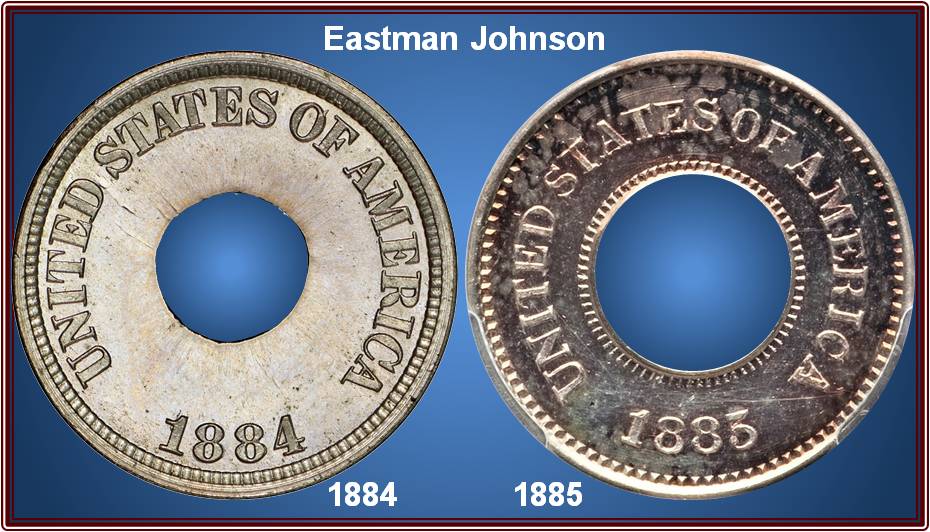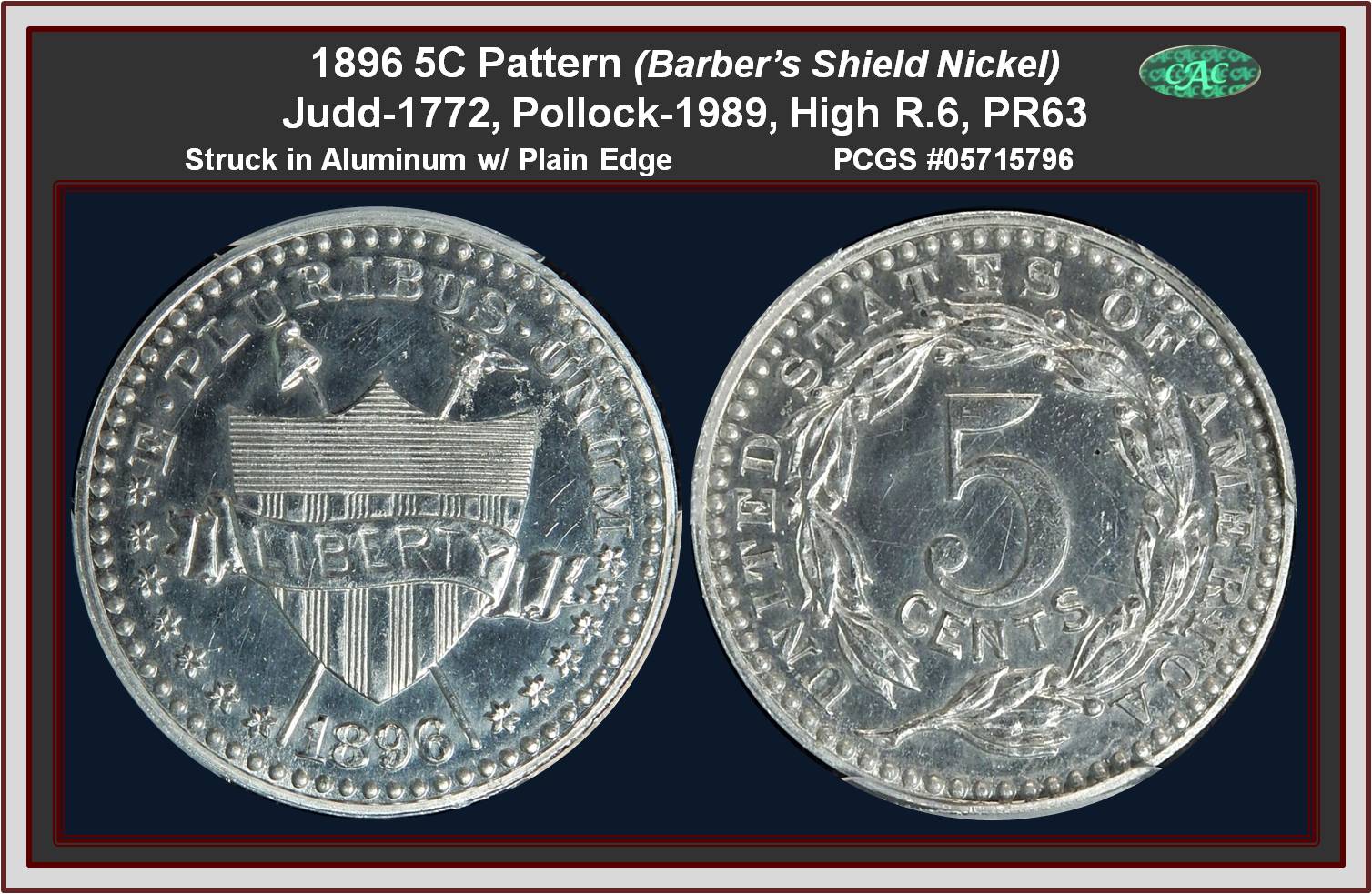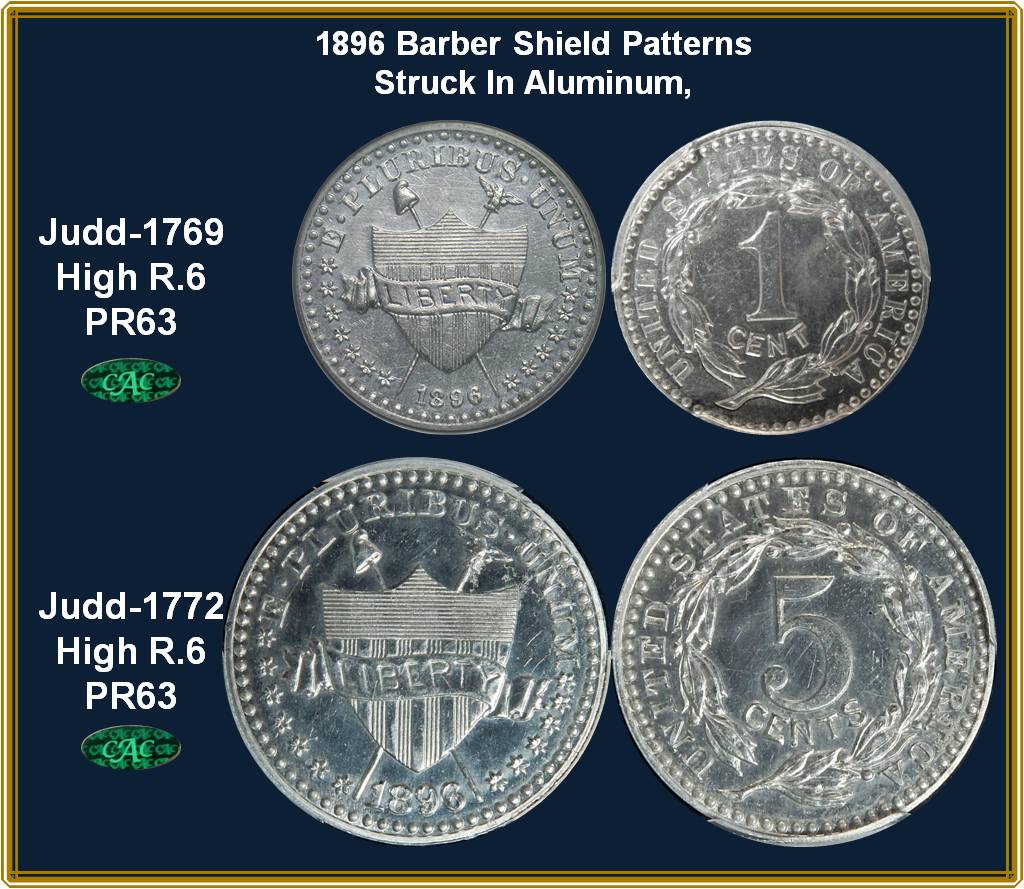
Set Description
THE PARTY IS OVER ... Patterns Winding down
(Click on thumbnail images to enlarge)
1884 & 1885 - Holey Moley more Holes, Eastman Johnson Holey Design?
I guess the mint just continued to play around with pattern designs without any real consideration to making changes with these pieces. Eastman Johnson was an artist that seem to proposed these "Holey Designs" earlier and the mint picked up experimenting around with a Holey Design concept that they abandoned 40 years earlier..
The pieces of 1884 were struck on perforated planchets and as such irregular shapes resulted when the metal was squeezed in the minting process. The pieces seem crude as a result.
 In 1885, a modification to the Eastman design were made with cutting in dentils around the inner perforation as well the outer rim. This did yield a crisper & tighter striking around the perforation and sharper design overall. Great interest is that both the 1 Cent & 5 Cent pieces of 1885 were struck in silver which had only been recorded on a few earlier patterns in these denominations, making these pieces more unique, The one cent was also cut with a 3 by mistake and had to be corrected to a 5. Seems strange an error like this happens when there were so few pieces being worked. In 1885, a modification to the Eastman design were made with cutting in dentils around the inner perforation as well the outer rim. This did yield a crisper & tighter striking around the perforation and sharper design overall. Great interest is that both the 1 Cent & 5 Cent pieces of 1885 were struck in silver which had only been recorded on a few earlier patterns in these denominations, making these pieces more unique, The one cent was also cut with a 3 by mistake and had to be corrected to a 5. Seems strange an error like this happens when there were so few pieces being worked.
DID I JUST SEE YOU IN MY POCKET? SHIELD PATTERN DESIGN OF 1896
Once again the House of Representative's requested the treasury to review the merits of different Nickel compositions and other metals in coinage. As a result numerous 1 Cent and 5 Cent pieces were struck with a wide range of materials. The patterns were dies of by Charles Barber and featured a shield design with the date on the obverse and on the reverse a wreath with either the "1" or "5" in the center.
It is interesting that a shield Cent design by Barber resurfaces 110 years later with the Lincoln Cent production.
Click below link to Return to Mania's Master Pattern Registry
Mania's US Patterns- WHAT U.S. COINAGE COULD HAVE BEEN
======================================
Set Goals
My goal with the Eastman Johnson sample are to collect one exhibit of the 1 cent and 5 cent types for each year that I accomplished with the help of the Simpson sale.


| | | | | | |
| | | | | | |
|
View Coin
| One Cent
Holey Cent
Stuck in Nickel |
United States
|
1C 1884 J-1721 LEMUS COLLECTION
|
NGC PF 64
|

1884 1C 'Holey' One Cent
Judd-1721, Pollock-1929
Rarity: R.5, PR64
Ex Lumus
Struck in nickel with a plain edge.
Obverse: The Eastman Johnson "holey cent" design. The planchet is holed at the center. The obverse has UNITED STATES OF AMERICA above and the date below, with no other design or ornament.
Reverse: Shows ONE CENT above with an inverted shield and wheat stalks below, within which the fields are open.
Comment:
The silver-gray surfaces demonstrate a modicum of field-device contrast, more so on the reverse than on the obverse. Some planchet irregularity in the form of light "waves" appears, possibly caused by the uneven pressure from striking caused by the center hole.
Both one cent and five cent patterns of this year feature the unusual Eastman Johnson "holey" design, apparently spurred by comments that the artist made in 1870, according to the Pollock reference. Some three to four dozen examples likely exist today.
Provenance/ Appearances:
Private Sale Dec 2014, From The Lemus Collection, Queller Family Collection Part Two, Heritage Jan 2009 FUN - Orlando, Fl / Lot 1953 and prior Stack's & Bowers Sept. 1985, The September Sale: United States Gold, Silver & Copper Coins /Lot 52 ($852)
================================================
Eastman Johnson Holey Patterns of 1884

|

|
|
View Coin
| Five Cent
Holey Cent
Stuck in Nickel |
United States
|
5C 1884 J-1724
|
PCGS PF 66
|

1884 5C -The Eastman Johnson "holey five cent" design.
Judd-1724, Pollock-1934
Rarity: Low R.6, PR66
Struck in nickel with plain edge
Obverse: The Obverse shows UNITED STATES OF AMERICA at the outer rim, with an inner circle of 13 stars and date 1884 below.
Reverse: The reverse shows FIVE above and CENTS below a roughly octagonal opening (probably handcut) in the planchet, with shields on either side.
Comments:
The nickel strikings were produced on thick and thin planchets. This appears to be a thick-planchet variant. About two dozen pieces are believed known in total of the nickel strikings. About a dozen aluminum pieces are also known as is a single white metal piece.
The strike details on this piece are remarkably strong, but as often seen on nickel patterns, the fields are only moderately reflective. Remarkably clean and attractive surfaces.
Provenance/ Appearance:
From The Indian Rocks Collection. Heritage April 2016 CSNS - Chicago / Lot #5625
|

|
|
View Coin
| One Cent
Holey Cent
Stuck in Silver |
United States
|
1C 1885 J-1740
|
PCGS PF 65
|

1885 1C Eastman Johnson Design
Judd-1740, Pollock-1950
Rarity: High R.6, PR65
Ex: Simpson
Struck in silver with a plain edge.
Obverse: An annular (ring-shaped) pattern cent with a central perforation. The obverse has UNITED STATES OF AMERICA above with the date 1885/3 at the bottom of that side.
Reverse: ONE CENT is in large letters at the top with a small shield that is flanked by laurel sprigs below.
Comment:
Rick Snow reports about 10 pieces known, two of which are slightly worn. Delicately toned in reddish-gold and cobalt-blue patina, this Gem retains considerable mint brilliance. The underlying fields flash appreciably.
The digit 5 is over a 3, one of the few overdates among pattern coinage. The overdate feature is especially prominent, with a flat-top digit 3 below the final 5, giving a flat appearance to the normally curved top of the 5. This may suggest that dies for Johnson’s proposal were prepared in 1883.
Numerous die lines are visible on the obverse. The reverse has a crack from the outer border to the inner border, through the right side of N in ONE and seen other pieces
Wt. 54.35 grains.
Provenance/ Appearances:
From The Bob Simpson Collection Heritage Jan 2021 FUN Signature Auction / Lot #3272, Priors
- Stacks Oct 2003 ( 68th Anniversary Sale - Rothchild Collection) / Lot #1023;
- New Netherlands Jun 1970 61st sale (Jesse Taylor Estate) - REMARKABLE U. S. PATTERNS AND RELATED COINS From the Estate of Jesse M. Taylor, Buffalo, New York
- From Barney Bluestone’s 92nd auction, April 26, 1946, / Lot #1263. Plate ($250.00
|

|
|
View Coin
| Five Cent
Holey Cent
Stuck in Silver |
United States
|
5C 1885 J-1742
|
PCGS PF 64
|

1885 5C
Judd-1742, Pollock-1954
Rarity: High R.6, PR64
Ex: Simpson.
Struck in silver with a plain edge.
Obverse: An annular pattern with thirteen stars, the date, and UNITED STATES OF AMERICA on the obverse.
Reverse: The upper reverse exhibits FIVE CENTS with a shield sandwiched between two laurel leaves on the exergue.
Comment:
This boldly struck Choice pattern displays pleasing magenta, sky-blue, and golden-brown toning.
The reverse has an intermittent circular impression from a mis-calibrated attempt at creating the central perforation, as made
Provenance/Appearance:
From the Bob Simpson Collection, Heritage Nov 20 /Lot#3276; Priors
- Kreisberg 2/76 per USpatterns.com
- Superior 5/93 Lot 1242
- Bowers Merena 3/8/1997 Sales of The Collections of Herman Halpern & Gerald O. Warner / lot #2055
- Goldberg Sept 2010 Pre Long Beach (The Estate of Winthrop A. Haviland,) / Lot 2778 (AsNGC64)
|

|
|
View Coin
| 1C Shield
Bronze |
United States
|
1C 1896 J-1768
|
NGC PF 64 BN
|

1896 1C One Cent
Judd-1768, Pollock-1985A
RARITY: R.5/High R.7, PR64 BN CAC Endorsed
Struck in bronze with a plain edge.
Obverse:
Charles Barber design uses a Federal shield as its primary motif. The shield has 13 strips and the motto E PLURIUS UNIM above and date below. 2 crossed poles are behind the shield This 1896 pattern design features a large shield in the center of the obverse with crossed poles behind a Liberty Cap on one and Eagle on the other, A large ribbon across the center of the shield with “LIBERTY” inscribed.
Reverse: A large numeral 1 with “CENTS” in small letters below, surrounded by a curved olive sprig and UNITED STATES OF AMERICA around the perimeter.
Comment:
Two varieties are known for this pattern. This variant, Pollock-1985A discover by Harry Bass, shows the eagle pointing toward the open space to the right of the S in PLURIBUS and is considered rare.
The surfaces are even, chocolate-brown over each side, and there is slight high-point weakness
Provenance/ Appearance:
Private sale 9/2015; Prior Heritage June 2014- Long Beach / Lot #5039 ($3875)
|

|
|
View Coin
| 1C Shield
Aluminum |
United States
|
1C 1896 J-1769
|
PCGS PF 62
|

1869 1C
Judd-1769, Pollock-1985
Rarity: High R.6 PF62 CAC Endorsed
Struck in aluminum with a plain edge.
Obverse: The obverse has a shield draped with a ribbon inscribed LIBERTY, poles in the background topped with a cap and an eagle. E PLURIBUS UNUM is placed at the top border with the date below, seven stars left and six right.
Reverse: The reverse has a single olive branch curved around 1 CENT with UNITED STATES OF AMERICA around.
Comment:
Fully brilliant and highly lustrous with satiny silver-gray surfaces with some minor blemishes of various types that limit the grade.
Bowers writes in 1999 “ This issue is quit significant as the latest date readily obtainable pattern of denomination. A long time ago in the 1950’s Bowers had acquired a cache of 1896 pattern cents and five-cent pieces from Robert K. Botsford, of Nescopek, PA, who obtained them from the estate of William H. Woodin (who lived not far away in Berwick, PA).
Called aluminum for sake of brevity, Pollock-1985 is actually found in many variations of the metal. In his United States Patterns and Related Issues, Andrew Pollock noted the following compositions for the type, none of which can be told from any of the others without extensive elemental analysis: (1). 100% aluminum; (2). 98.78% aluminum, .40% iron, .45% silicon, .37% cop¬ per; (3). 96.94% aluminum, .65% iron, .38% silicon, 2.03% copper; and (4). 96.74% aluminum, .45% iron, .31% silicon, 1.94% copper, .56% manganese
Provenance/ Appearances:
Private Sale 2/2020 priors:
-From The Jones Beach Collection, Heritage Jan 2007 Orlando, FL (FUN) / Lot #1629;
-From the William H. and Pauline M. Bonn Birth Year/Memorial Collection. Stacks and Bowers Aug 2012 Philadelphia ANA / Lot #12137;
- Also believe to be from Bowers and Merena Sept 1999 (The Collections of Emil Voigt, Sr. & Dr. Wallace Lee) /Lot #20
================================================
Aluminum Set

|

|
|
View Coin
| 5C Shield
Nickel |
United States
|
5C 1896 J-1770
|
NGC PF 64
|

1896 5C Five Cents
Judd-1770, Pollock-1987
Rarity: Low R.6, PR64
Struck in a nickel alloy with a plain edge.
Obverse:
Charles Barber design uses a Federal shield as its primary motif. The shield has 13 strips and the motto E PLURIUS UNIM above and date below. 2 crossed poles are behind the shield This 1896 pattern design features a large shield in the center of the obverse with crossed poles behind a Liberty Cap on one and Eagle on the other, A large ribbon across the center of the shield with “LIBERTY” inscribed.
Reverse:
A large numeral 5 with CENTS in small letters below, surrounded by a curved olive sprig.
Comment:
A fully struck, glossy, and satiny specimen that exhibits light almond-gold toning. The fields show moderate flash and are without visible detractions
Provenance/ Appearance:
Private transaction Dec 2014, Prior Heritage Jan 2013 FUN Signature Auction - Orlando / Lot #6751
|

|
|
View Coin
| 5C Shield
Aluminum |
United States
|
5C 1896 J-1772
|
PCGS PF 63
|

1896 5C Five Cents
Judd-1772, Pollock-1989
Rarity: High R.6, PR63 CAC Endorsed (New holder since)
Struck in aluminum with a plain edge.
Obverse:
A shield with 13 strips and the motto E PLURIUS UNIM above and date below. 2 crossed poles are behind the shield This 1896 pattern design features a large shield in the center of the obverse with crossed poles behind a Liberty Cap on one and Eagle on the other, A large ribbon across the center of the shield with “LIBERTY” inscribed.
Reverse:
A large numeral 5 with CENTS in small letters below, surrounded by a curved olive sprig.
Comments:
One of several experiments during the year with different metallic compositions. By 1896, pure aluminum was becoming much less expensive due to improvements in separating it from its many alloys, and it was therefore given more serious consideration as a viable metal for small-denomination coinage.
Pollock lists four different alloys for this aluminum type sighing the June 30, 1897 Annual Mint Director report where they listed 4 different Aluminum compositions and weights.
100% Aluminum, 98.78% Aluminum, 96.94% Aluminum, 96.74% Aluminum
This piece devices are slightly frosted satiny mirror like fields with no rusting and only slight handling marks.
Provenance/ Appearance:
Great Collections Auction Sept 6, 2020 /Lot 880412; It is also possible the same as Superior’s 6/1/1993 113th Sale /Lot 1245
==================================
Type Set Features

|

|
  
 | Loading… |
|
|